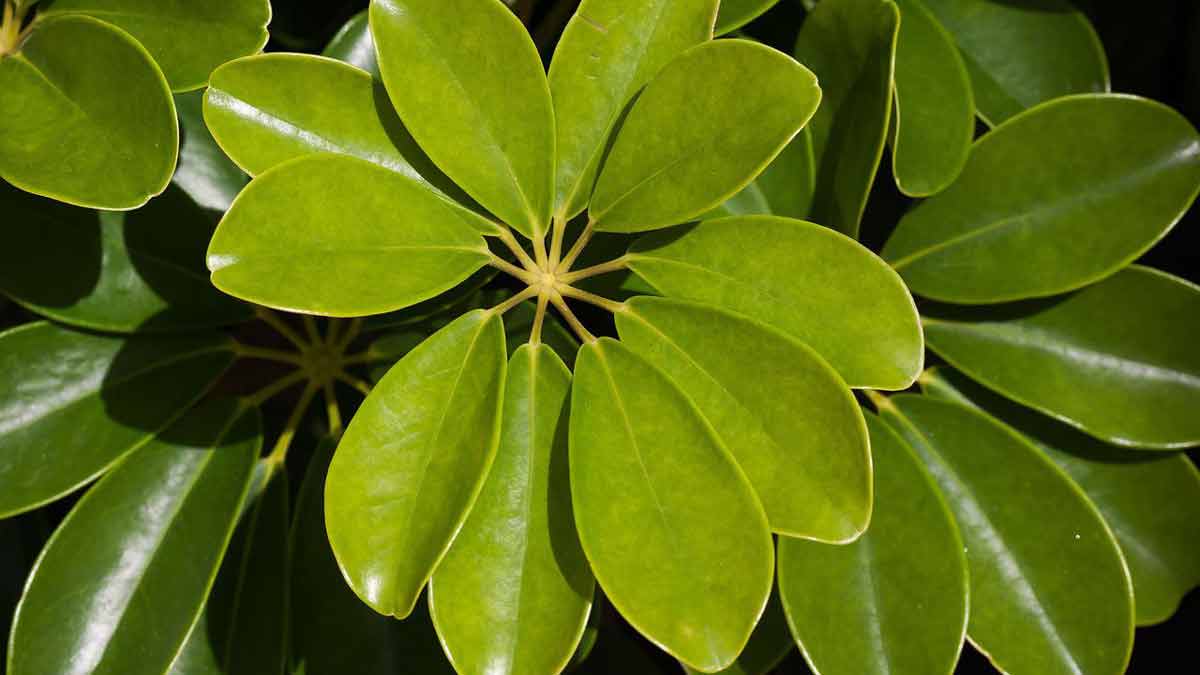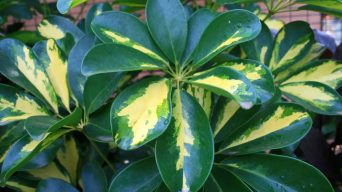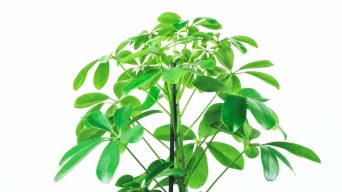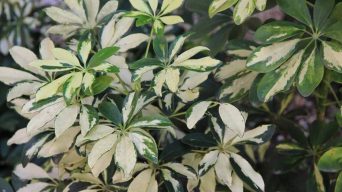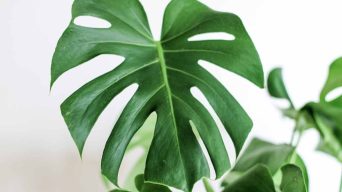A dying umbrella plant could be caused by improper watering, lack of sunlight, or root rot. Check the soil moisture, move the plant to a brighter area, and look for signs of pests and fungal diseases to rule out and diagnose the issue.
Is your elegant umbrella plant losing its lustrous charm? Are you worried by the wilting leaves that once gave your space an eco-friendly embrace?
Fear not-green-thumb enthusiasts, it’s time to roll up your sleeves and rescue your dying umbrella plants!
This blog post will guide you through simple yet effective steps to troubleshoot common problems.
Let’s plunge into the realm of restoration and revive your fading green friend back to flourishing health.
Let’s bring your umbrella plant – and your indoor jungle dreams – back to life!
Facts and Statistics
- One study found that overwatering, which can lead to root rot, is responsible for the death of up to 80% of houseplants, including umbrella plants.
- It has been estimated that around 50% of indoor plants may be affected by pests like mealy bugs and spider mites, another common cause of plant death.
- According to a survey, inadequate sunlight – which can cause problems like brown spots on leaves – affects nearly 70% of indoor plants such as the umbrella plant.
Reasons Your Umbrella Plant is Struggling
Is your once vibrant and lush umbrella plant now showing signs of distress? Don’t worry, you’re not alone.
Many plant enthusiasts have faced the challenge of reviving their struggling umbrella plants. To tackle this task effectively, it’s crucial to understand the potential reasons behind their decline.
One common culprit is overwatering. Umbrella plants are susceptible to root rot if given excessive water, leading to wilted leaves and a weakened overall appearance.
On the other hand, underwatering can cause troubles, resulting in pale and withered leaves.
It’s important to strike a balance between providing adequate water and avoiding both overhydration and dehydration.
Let’s say you recently moved your umbrella plant to a new spot near a window with direct sunlight. You noticed that its leaves are developing brown spots. This could indicate that inadequate light exposure is causing stress to your plant, hindering its ability to thrive.
Think of your umbrella plant as a delicate dance partner who requires just the right amount of light, temperature, and hydration to perform gracefully.
Just as too much pressure can result in missteps or strained movements, improper care can weaken your green companion’s state.
Now that we have explored some potential causes for an umbrella plant’s struggle let’s focus on one specific issue: overwatering.
Overwatering Consequences and Signs
Overeager waterers may inadvertently drown their beloved umbrella plants with excessive moisture.
The consequences of overwatering can be detrimental to the health of these plants, so it’s important to identify the signs and take appropriate action.
When an umbrella plant is overwatered, its roots can become saturated for extended periods, leading to root rot.
You may notice the leaves turning yellow or brown and appearing limp or droopy. These symptoms indicate that the roots are struggling to absorb nutrients properly.
Imagine overwatering your umbrella plant as if you were giving it a never-ending rainstorm. While water is essential, too much will cause the delicate roots to drown in the constant deluge, resulting in an unhappy and unhealthy plant.
To combat overwatering, allow the soil to partially dry out before watering again.
A general guideline is to water the plant once per week and ensure good drainage by using a pot with adequate drainage holes or adding a layer of gravel at the bottom.
Additionally, consider removing any excess standing water from a saucer or tray beneath the pot, which can contribute to prolonged soil moisture levels.
Increasing ventilation around the plant can also help dry out the soil more efficiently.
If your umbrella plant has fallen victim to overwatering, there are ways to nurse it back to health.
Temporarily suspend watering for about a week to allow the soil to dry out and prevent further root damage.
If necessary, gently loosen compacted soil around the roots to improve drainage.
Low Sunlight Exposure and Cold Damage
One of the common reasons why umbrella plants may start to wither and show signs of distress is low sunlight exposure.
These tropical plants thrive in bright, indirect light, and insufficient sunlight can impede their growth and health.
If you notice your umbrella plant developing brown spots on its leaves or looking leggy and stretched out, it might result from inadequate light.
To address this issue, you’ll need to adjust the lighting conditions for your umbrella plant.
Find a location in your home that receives 4-6 hours of indirect sunlight daily, preferably near a window.
However, be cautious not to expose the plant to direct sunlight as it can scorch the leaves and cause further damage.
By ensuring proper light exposure, you’ll provide the necessary energy for your umbrella plant to thrive.
Cold damage is another factor that can contribute to your umbrella plant’s health decline.
These plants are native to warm regions and prefer temperatures between 60-90°F (15-33°C). When exposed to temperatures below 50°F (10°C), they may suffer from cold stress.
Frost or prolonged exposure to chilly drafts can cause leaves to turn black, wilt, or even drop off.
If you suspect cold damage, adjust the placement of your umbrella plant away from windows or drafty areas that might expose it to low temperatures.
Consider using a thermometer to monitor the temperature around the plant and ensure it remains within the ideal range.
During colder months, opening windows for short periods can help increase ventilation and prevent stagnant air pockets.
It’s important to note that each plant has its own tolerance level for temperature fluctuations.
By monitoring and adjusting light exposure and temperature conditions, you can help minimize the negative impacts of these factors on your umbrella plant’s health.
Reviving Your Dying Umbrella Plant
Now that we’ve discussed the potential issues of low sunlight exposure and cold damage let’s dive into the steps you can take to revive your dying umbrella plant.
It’s important to note that these steps depend on the specific problem you’ve identified with your plant, so be observant and adapt accordingly.
- Assess watering habits: Overwatering or underwatering can both have detrimental effects on your umbrella plant. Check the soil’s moisture level by inserting your finger up to the first knuckle. Adjust your watering routine if the soil feels excessively wet or bone dry. Aim to water the plant once weekly, ensuring excess water drains away to prevent root rot.
- Address root issues: If overwatering has caused root rot, it’s essential to take immediate action. Stop watering the plant for a week to allow the soil to dry out partially. Remove any trays or saucers beneath the pot to prevent standing water. Consider repotting the plant in fresh, well-draining soil if necessary.
- Combat pests: Pests like mealy bugs and spider mites can also contribute to the decline of your umbrella plant. Carefully examine the leaves and stems for signs of infestation. If you spot any pests, isolate the plant from others to prevent spreading. Remove them by spraying a mixture of water and rubbing alcohol onto affected areas or using a mild insecticidal soap. Trim off any damaged leaves or stems as well.
- Boost humidity: Increasing humidity levels can aid in reviving an umbrella plant struggling due to dry conditions. You can mist the leaves regularly or place a pebble tray filled with water beneath the pot. As the water evaporates, it will create a humid environment around the plant.
- Monitor overall care: Pay attention to other aspects of care, such as fertilizer application and proper pruning techniques. Don’t overdo fertilizing, as it can harm your plants. Regularly trim dead or yellowing leaves to promote overall plant health.
By following these steps, you’ll create a favorable environment for your umbrella plant to recover and regain its vitality.
To revive a an umbrella plant, it’s crucial to assess its watering habits and adjust as needed, address root issues such as root rot, combat pests by isolating the plant and using appropriate remedies, boost humidity levels through misting or a pebble tray, and monitor overall care including fertilizing and pruning. By following these steps, your umbrella plant can recover and thrive.
Adjusting Light Exposure & Temperature
When troubleshooting the decline of your beloved umbrella plant, examining its light exposure and temperature conditions is paramount. These two factors are crucial to the plant’s overall health and vitality.
Umbrella plants thrive in indirect sunlight, typically needing 4-6 hours of it per day to flourish.
Insufficient light can result in brown spots on the leaves, indicating stress.
To ensure ample light exposure, position your plant in a well-lit area of your home, preferably one that receives bright but indirect sunlight throughout the day.
Avoid placing it under direct sunlight, as this can lead to sunburn and harm the plant.
Temperature also influences the well-being of your umbrella plant.
Ideally, these tropical beauties prefer temperatures ranging between 60-90°F (15-33°C). Extremely low or high temperatures can hinder growth and cause distress.
If you notice your plant suffering from extreme temperature fluctuations, adjust its placement near a window accordingly.
Additionally, use a thermometer to monitor the temperature consistently and open windows for increased ventilation.
For added humidity and temperature control, you can employ creative techniques such as clustering plants together or using a humidifier.
Adjusting the light exposure and temperature levels to suit your umbrella plant’s preferences provides a conducive environment for revival.
Correct Watering Techniques & Soil Adjustments
The next aspect to address when troubleshooting an umbrella plant that’s dying pertains to proper watering techniques and soil adjustments.
Overwatering and underwatering are common culprits behind their decline.
Overwatering can be detrimental to umbrella plants as it leads to root rot due to excessive moisture in the soil.
Establishing a regular watering schedule for your plant is essential by providing ample hydration without drowning it.
While there isn’t an exact frequency that applies universally, watering your umbrella plant once a week, allowing the soil to dry out slightly between watering sessions, is generally recommended.
To avoid water accumulation at the bottom of the pot, which can exacerbate overwatering issues, utilize a pebble tray to catch excess water.
If you suspect that your umbrella plant may be suffering from overwatering, take remedial steps by temporarily withholding watering for a week.
Remove the pebble tray during this period to facilitate better air circulation and warmth around the plant’s roots. Additionally, ensure proper ventilation in the room to prevent moisture buildup.
If the issue persists, consider repotting the plant after removing any affected or soggy portions of the root system.
On the other hand, underwatering can also contribute to an umbrella plant’s decline with symptoms like pale or withered leaves.
In such cases, it’s essential to provide a hydration boost.
One method is to soak the entire plant in a sink or basin filled with water for about 5-10 minutes, allowing it to absorb moisture and revive. This technique helps rehydrate plants effectively.
If you find yourself consistently underwatering your umbrella plant, another potential culprit may be the soil itself.
Some substrates have difficulty retaining moisture adequately. Consider adjusting the soil composition by incorporating materials that promote better water retention while maintaining adequate drainage.
For example, if your potting mix mainly consists of peat moss, add some perlite or vermiculite to improve drainage and prevent waterlogged conditions.
With adjusted watering techniques and suitable soil adjustments, you can address overwatering and underwatering issues and help your umbrella plant regain its vibrancy and resilience.
Preventing Future Troubles
Taking preventive measures is key to ensure your umbrella plant’s health and vitality.
By implementing a few simple practices, you can minimize the risk of encountering troubles in the future.
First and foremost, monitor and regulate your watering routine.
Overwatering is a common cause of umbrella plant demise, as it can lead to root rot.
Water the plant once per week, allowing the soil to dry out slightly between waterings. To catch any excess water, consider using a pebble tray or placing a saucer beneath the pot.
Let’s say you have been diligently following a weekly watering schedule, but you notice your umbrella plant starting to show signs of trouble.
The leaves are turning yellow and drooping. In this case, it might be an indication of overwatering. Take a step back and reevaluate your watering habits.
If you suspect overwatering is the issue, skip watering for a week and remove the pebble tray or saucer to promote better drainage. This allows the soil to dry out and allows the roots to recover.
Additionally, make sure the plant is placed in a well-ventilated area with ample air circulation to prevent moisture buildup.
On the other hand, underwatering can also lead to leaf problems such as wilting and pale foliage.
If you notice these symptoms, boost your umbrella plant by soaking it in a sink or basin of water for about 5-10 minutes. This helps replenish moisture levels in the root system.
Now that we’ve discussed preventive measures regarding watering habits let’s explore another important aspect: keeping pests away and implementing proper fertilizing practices.
Keeping Pests Away & Fertilizing Practices
Umbrella plants, like many houseplants, can fall victim to pesky pests that disrupt their growth and overall health.
Two common offenders are mealy bugs and spider mites. These pests can suck the nutrients out of your plant, leading to weakened foliage and stunted growth.
It’s crucial to establish a proactive defense strategy to keep these unwanted visitors at bay.
Start by regularly inspecting your umbrella plant for any signs of pest infestation. Look for tiny webs, sticky residue, or small white bugs on the leaves and stems.
If you spot pests, take immediate action to eradicate them.
One effective method is to spray water and rubbing alcohol onto the affected areas. This solution helps control the insects without harming the plant.
For more severe infestations, consider using an insecticidal soap or neem oil as directed on the product label.
Imagine discovering a cluster of mealy bugs on your beloved umbrella plant. You panic, fearing the worst for its survival.
Take a deep breath and trust that you can save your plant from further damage with timely intervention and persistence.
Remember to focus on the visible pests and address damaged leaves by pruning them away. Dispose of these pruned parts properly, far away from other plants, to prevent spreading any potential infestation.
Apart from pest prevention, proper nutrition through fertilizing practices is essential for keeping your umbrella plant healthy and thriving.
Use a balanced liquid houseplant fertilizer and apply it according to the manufacturer’s instructions.
Having covered the importance of keeping pests away and implementing appropriate fertilizing practices, let’s shift our attention toward ensuring your umbrella plant’s healthy growth and longevity.
Ensuring Healthy Growth and Longevity of Your Schefflera Plant
When it comes to cultivating a thriving umbrella plant, there are several key factors to consider.
By addressing these aspects, you can ensure healthy growth and longevity for your beloved foliage. Let’s explore some essential tips and tricks:
First and foremost, watering is crucial for maintaining optimal plant health.
Umbrella plants prefer moist but not waterlogged soil. Overwatering can lead to root rot, while underwatering can cause pale, withered leaves. Striking the right balance is essential.
To avoid overwatering, water the plant once weekly and use a pebble tray beneath the pot to catch excess water. The tray prevents the roots from sitting in standing water, reducing the risk of root rot.
Imagine watering your umbrella plant excessively for weeks, causing the roots to suffocate in soggy soil.
You realize your mistake as you notice yellowing leaves and a foul smell emanating from the pot.
You remove the pebble tray, allow the soil to dry out partially, and increase ventilation by moving it to a well-ventilated area.
After a few weeks of diligent care, new shoots start sprouting from the base, providing a glimmer of hope for its revival.
Next, addressing pests is crucial to ensure the plant’s longevity.
Common pests like mealybugs and spider mites can drain nutrients from your umbrella plant, leading to stunted growth or even death.
Regularly inspect your plant for signs of infestation, such as tiny webs or cotton-like clusters on the leaves or stems. If you spot any pests, act quickly to eradicate them.
Some gardeners argue that chemical pesticides are necessary for effectively combating persistent pests.
While these products may provide immediate relief, they can also harm beneficial insects and impact the overall health of your plant.
An alternative approach involves using a mixture of water and rubbing alcohol in a spray bottle to remove pests physically.
You can restore your plant’s health without resorting to harsh chemicals by spraying the affected areas and wiping away any dead bugs.
Remember to prune off any damaged leaves or stems during this process.
Besides watering and pest control, light and temperature play crucial roles in an umbrella plant’s well-being. These plants thrive in moderate to bright, indirect sunlight, so finding the perfect spot for them is vital.
Consider placing your plant near a window receiving 4-6 hours of indirect sunlight daily. Be cautious of direct sunlight, leading to burned tips on the foliage.
Imagine placing your umbrella plant in a dark corner of your living room, far from any windows. As weeks go by, you notice the leaves turning brown and drooping.
Realizing the lack of sufficient light, you relocate the plant to a brighter area near a window. Over time, new leaves start developing their characteristic vibrant green color, illustrating how vital proper lighting is for its growth.
Lastly, don’t overlook the importance of maintaining optimal temperature conditions for your umbrella plant.
The ideal temperature range is between 60-90°F (15-33°C), with a minimum of 50°F (10°C) and maximum of 100°F (37°C). Fluctuations outside this range can stress or harm the plant.
By diligently monitoring the environment and adjusting placement as needed for both light and temperature control, you can provide your umbrella plant with optimal growing conditions, promoting healthy growth and ensuring its longevity.
Final Thoughts
Reviving a dying Schefflera, the umbrella plant, involves addressing common issues such as overwatering, improper lighting, and pest infestations.
By assessing the plant’s needs and taking appropriate steps to adjust its care, you can nurse it back to health and restore its vibrancy.
Proper watering techniques, soil adjustments, and maintaining ideal light and temperature conditions are essential to successful plant care.
Pest prevention and fertilization practices are vital in ensuring your umbrella plant’s healthy growth and longevity.
By following these tips and tricks, you can breathe new life into your fading green friend and enjoy the beauty of a flourishing umbrella plant once again.

